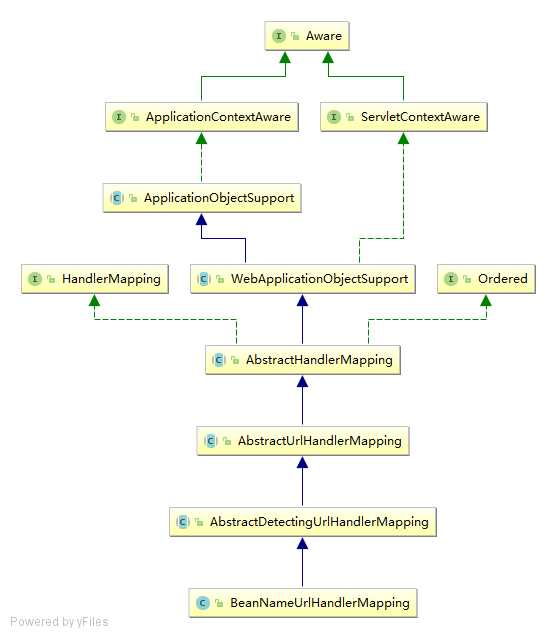先介绍一下:
BeanNameUrlHandlerMapping是基于配置文件的方式; 所有处理器需要在XML文件中,以Bean的形式配置。
缺点:配置繁琐; 如果多个URL对应同一个处理器,那么需要配置多条,同时也会实例化多个对象等等。。。
因为springmvc 是基于spring的,所以他的初始化肯定是在spring容器初始化之后才进行的。
先上类图:

可以看到BeanNameUrlHandlerMapping父类最终实现了ApplicationContextAware接口,所以Spring容器会自动注入ApplicationContext,方法为:
1 public final void setApplicationContext(ApplicationContext context) throws BeansException { 2 if (context == null && !this.isContextRequired()) { 3 this.applicationContext = null; 4 this.messageSourceAccessor = null; 5 } else if (this.applicationContext == null) { 6 if (!this.requiredContextClass().isInstance(context)) { 7 throw new ApplicationContextException("Invalid application context: needs to be of type [" + this.requiredContextClass().getName() + "]"); 8 } 9 10 this.applicationContext = context; 11 this.messageSourceAccessor = new MessageSourceAccessor(context); 12 this.initApplicationContext(context); //这块实际上是一个钩子方法,供子类去覆盖! 进行初始化工作 13 } else if (this.applicationContext != context) { 14 throw new ApplicationContextException("Cannot reinitialize with different application context: current one is [" + this.applicationContext + "], passed-in one is [" + context + "]"); 15 } 16 17 }
AbstractHandlerMapping: 这个类就是复写了这个方法 进行了拦截器的初始化
protected void initApplicationContext() throws BeansException { this.extendInterceptors(this.interceptors); //供子类扩展拦截器 this.detectMappedInterceptors(this.mappedInterceptors);//扫描应用下的MappedInterceptor,并添加到mappedInterceptors this.initInterceptors();//归集MappedInterceptor,并适配HandlerInterceptor和WebRequestInterceptor }
AbstractDetectingUrlHandlerMapping :同样重写这个方法,实现自己的逻辑
1 public void initApplicationContext() throws ApplicationContextException { 2 super.initApplicationContext(); 3 this.detectHandlers(); 4 } 5 6 protected void detectHandlers() throws BeansException { 7 if (this.logger.isDebugEnabled()) { 8 this.logger.debug("Looking for URL mappings in application context: " + this.getApplicationContext()); 9 } 10 // 扫描应用下所有的Object类 11 String[] beanNames = this.detectHandlersInAncestorContexts ? BeanFactoryUtils.beanNamesForTypeIncludingAncestors(this.getApplicationContext(), Object.class) : this.getApplicationContext().getBeanNamesForType(Object.class); 12 String[] arr$ = beanNames; 13 int len$ = beanNames.length; 14 15 for(int i$ = 0; i$ < len$; ++i$) { //遍历每一个扫描出来的类 16 String beanName = arr$[i$]; 17 String[] urls = this.determineUrlsForHandler(beanName); //钩子方法,让子类去实现,通过handler解析url 18 if (!ObjectUtils.isEmpty(urls)) { 19 this.registerHandler(urls, beanName); //返回的URL进行注册,实际上就是放到AbstractUrlHandlerMapping的一个map中 20 } else if (this.logger.isDebugEnabled()) { 21 this.logger.debug("Rejected bean name ‘" + beanName + "‘: no URL paths identified"); 22 } 23 } 24 25 }
BeanNameUrlHandlerMapping:实际上就实现了determineUrlsForHandler这个方法:
// // Source code recreated from a .class file by IntelliJ IDEA // (powered by Fernflower decompiler) // package org.springframework.web.servlet.handler; import java.util.ArrayList; import java.util.List; import org.springframework.util.StringUtils; public class BeanNameUrlHandlerMapping extends AbstractDetectingUrlHandlerMapping { public BeanNameUrlHandlerMapping() { } protected String[] determineUrlsForHandler(String beanName) { List<String> urls = new ArrayList(); if (beanName.startsWith("/")) { //只有一点需要注意 就是bean id 必须是以‘/‘开头 urls.add(beanName); } String[] aliases = this.getApplicationContext().getAliases(beanName); String[] arr$ = aliases; int len$ = aliases.length; for(int i$ = 0; i$ < len$; ++i$) { String alias = arr$[i$]; if (alias.startsWith("/")) { urls.add(alias); } } return StringUtils.toStringArray(urls); } }
AbstractUrlHandlerMappin:中注册处理器的方法:
1 protected void registerHandler(String urlPath, Object handler) throws BeansException, IllegalStateException { 2 Assert.notNull(urlPath, "URL path must not be null"); 3 Assert.notNull(handler, "Handler object must not be null"); 4 Object resolvedHandler = handler; 5 if (!this.lazyInitHandlers && handler instanceof String) { 6 String handlerName = (String)handler; 7 if (this.getApplicationContext().isSingleton(handlerName)) { 8 resolvedHandler = this.getApplicationContext().getBean(handlerName); 9 } 10 } 11 12 Object mappedHandler = this.handlerMap.get(urlPath); 13 if (mappedHandler != null) { 14 if (mappedHandler != resolvedHandler) { //不允许存在相同url不同handler,否则抛异常 15 throw new IllegalStateException("Cannot map " + this.getHandlerDescription(handler) + " to URL path [" + urlPath + "]: There is already " + this.getHandlerDescription(mappedHandler) + " mapped."); 16 } 17 } else if (urlPath.equals("/")) { 18 if (this.logger.isInfoEnabled()) { 19 this.logger.info("Root mapping to " + this.getHandlerDescription(handler)); 20 } 21 22 this.setRootHandler(resolvedHandler); 23 } else if (urlPath.equals("/*")) { 24 if (this.logger.isInfoEnabled()) { 25 this.logger.info("Default mapping to " + this.getHandlerDescription(handler)); 26 } 27 28 this.setDefaultHandler(resolvedHandler); 29 } else { //这才是正常的存储逻辑 30 this.handlerMap.put(urlPath, resolvedHandler); 31 if (this.logger.isInfoEnabled()) { 32 this.logger.info("Mapped URL path [" + urlPath + "] onto " + this.getHandlerDescription(handler)); 33 } 34 } 35 36 }
到这里实际上处理器映射器的保存工作就算完事了。
实际上handlerMapping这一块,主要思路就是 写一个模板类,来处理公共的方法,如初始化拦截器,然后留下钩子方法,让子类去实现自己的逻辑就好了。
